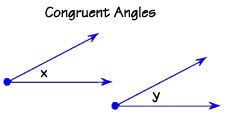top of page
Chapter 6.6 - Angles
We classify angles based on the size of the angle.
We measure the size of the angle by using a protractor like this.
Is this angle 50 degrees or 130 degrees?

If you said 50 degrees you are correct.
2 Hints:
1. You can see the angle is acute so you know it has to be less than 90 degrees.
2. If you started to count from the bottom of the angle, you would start at 0 and count up you would not start at 180 and count down.
Name, measure and classify angles
Lesson #1 Video Assignment
We can also classify angles based on the relationship with other angles.
Complementary angles are two angles whose sum is 90 degrees.

Supplementary angles are two angles whose sum is 180 degrees.

Vertical angles are pairs of angles directly opposite of each other,
formed by intersecting straight lines.

Congruent angles have the exact same measure.
Vertical angles are congruent.

Adjacent angles are angles immediately next to each other.

Identify complementary, supplementary, vertical, adjacent & congruent angles
Lesson #2 Video Assignment
Now, if I have you the measurements of some angles, could you use what you know about complimentary, supplementary, vertical, adjacent and congruent angles to solve for the unknown angles?
Find measures of complementary, supplementary, vertical, adjacent & congruent angles
Lesson #3 Video Assignment
A transversal is a line that cuts across two or more other lines.

Alternate Interior Angles are angles on opposite side of the transversal
but inside the two lines.
If the lines are parallel, alternate interior angles are congruent.

Alternate Exterior Angles are angles on opposite side of the transversal
but outside the two lines.
If the lines ar parallel, alternate exterior angles are congruent.

Corresponding angles are angle in matching corners.
If the lines are parallel, corresponding angles are congruent.

Transversal of parallel lines
Lesson #4 Video Assignment
bottom of page